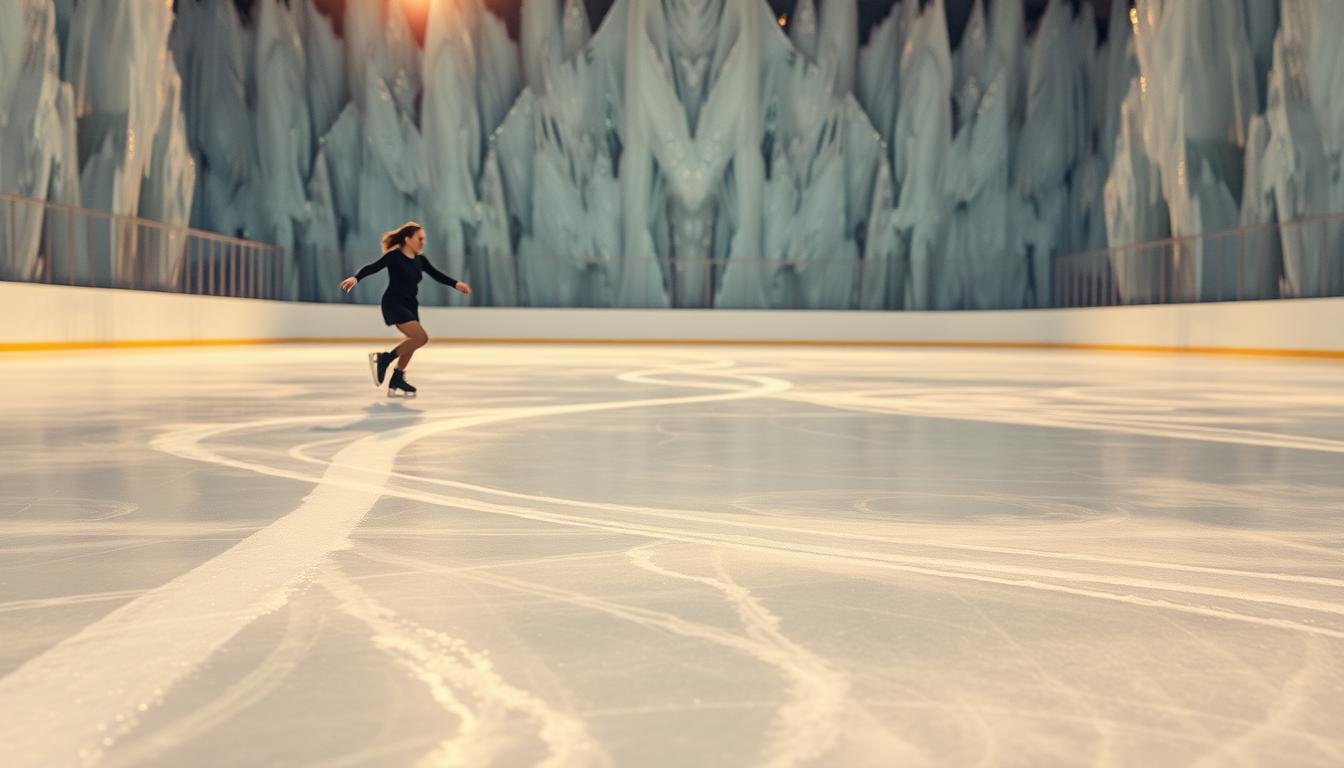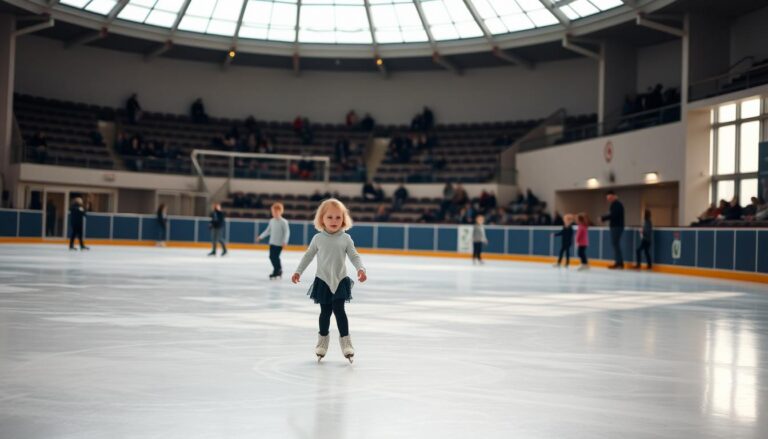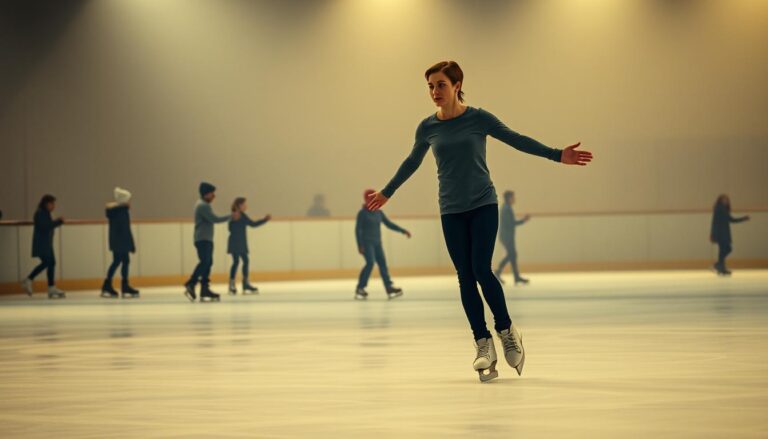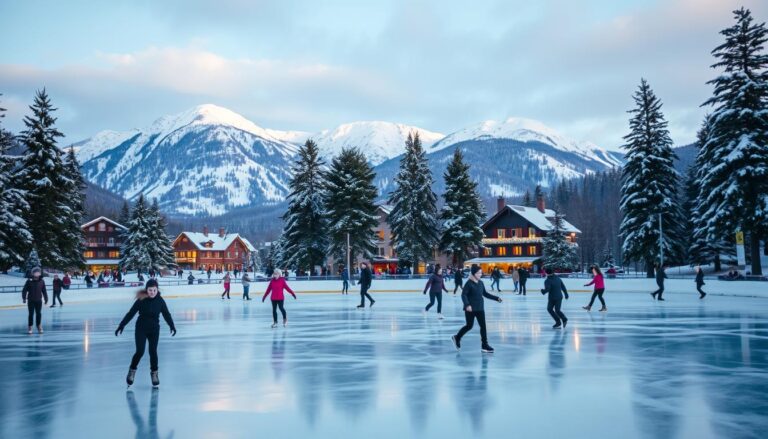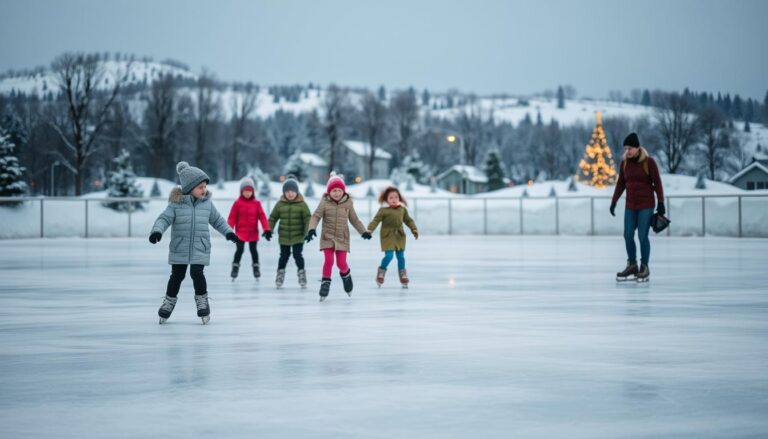Improve Your Ice Skating Skills: Tips and Techniques
Imagine your blades cutting through the ice for the first time. It’s a moment that turns shaky steps into smooth glides. Learning to skate better is more than just mastering moves. It’s about finding a new way to move and feel alive.
Ice skating is more than a sport; it’s a mix of art, athleticism, and joy. Starting your skating journey means you’re already on the path to greatness. You’re curious and eager to learn.
Skaters know that success on the ice comes from mental focus, physical fitness, and practice. Whether you aim for competitive skating or just want to skate well, this guide will help you.
Think about going from a beginner to a confident skater. Each skill you learn makes skating easier. Soon, you’ll find that what seemed hard is now simple.
This guide will give you expert tips on skating skills, safety, and advanced moves. You’ll learn how to align your body and do cool turns. You’ll get the secrets that pro instructors teach their students.
Your skating skills are waiting to be discovered. With regular practice and the tips in this guide, you’ll not only skate better. You’ll also feel more confident in your athletic abilities.
Are you ready to become a skilled, elegant, and powerful skater? Your journey to becoming a great skater begins today!
Getting Started: Essential Ice Skating Fundamentals
Stepping onto the ice for the first time can feel intimidating. But, mastering beginner ice skating techniques will boost your confidence and skill. Every professional skater began where you are now, learning the basic movements.
Developing proper skating skills starts with understanding key elements. These elements will help you succeed. Ice skating improvement tips focus on building a strong foundation of fundamental techniques.
Proper Skating Posture and Balance
Your body position is key in ice skating. Here are important posture guidelines:
- Keep your head up and eyes forward
- Bend your knees slightly (about 30-45 degrees)
- Maintain a straight back with relaxed shoulders
- Center your weight over the middle of your skating blades
Basic Stance and Weight Distribution
Achieving the right stance is vital for beginner ice skating techniques. Follow these weight distribution tips:
- Start with feet shoulder-width apart
- Distribute weight evenly between both feet
- Keep your center of gravity low
- Practice shifting weight smoothly between skates
Understanding Edge Control
Edge control is a key skill for skaters. Your ice skate blades have two important edges:
| Edge Type | Description | Skating Application |
|---|---|---|
| Inside Edge | Inner side of blade | Turning and carving curves |
| Outside Edge | Outer side of blade | Generating speed and momentum |
Pro tip: Practice edge control exercises off-ice to build muscle memory and confidence before hitting the rink.
How to Get Better at Ice Skating: A Comprehensive Guide
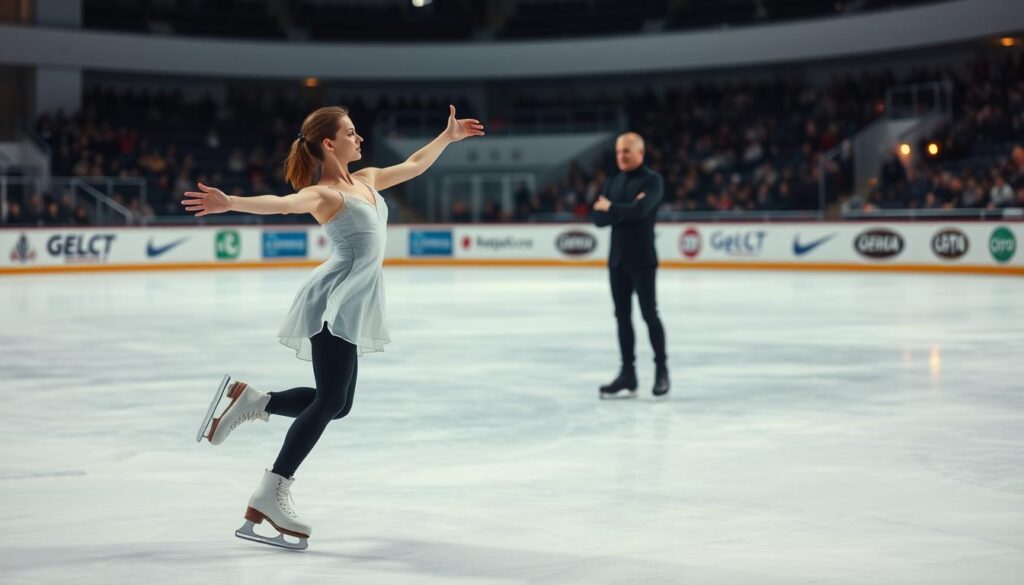
To improve at ice skating, you need a plan that includes physical training, mental prep, and regular practice. Focus on different parts of your skating to get better.
Create a detailed training plan to boost your skills. Here are key ways to improve your ice skating:
- Technical Skill Development
- Work on edge control
- Master foot placement
- Improve balance and core strength
- Physical Conditioning
- Do strength training off the ice
- Do flexibility exercises
- Work on your heart health
- Mental Preparation
- Use visualization
- Set clear goals
- Build confidence with practice
Professional skaters know it’s all about a complete approach. Regular practice and focused exercises can really boost your ice skating.
Working with a pro skating coach can help a lot. They give you feedback and point out what you need to work on. Watching videos of your skating can also show you where you can get better.
Remember, getting better takes time and effort. See each practice as a chance to get better and build muscle memory. With hard work and the right strategy, you’ll see big improvements in your skating.
Essential Ice Skating Safety Measures and Equipment
Safety is key to great ice skating. Whether you’re new or experienced, knowing the right gear and safety rules is vital. This guide will keep you safe while you enjoy the ice.
Choosing the Right Ice Skates
Finding the perfect ice skates is a big step. The right skates can greatly improve your skating and comfort.
- Make sure they fit well, with no more than 1/4 inch of heel movement
- Pick skates that match your skating style (recreational, figure, or hockey)
- Get a professional fitting at a skating shop
Protective Gear Requirements
Start with the right protection for beginner skating. Your safety gear is your first line of defense against injuries.
| Protective Gear | Purpose | Recommended for |
|---|---|---|
| Helmet | Head protection | All skill levels |
| Knee Pads | Joint protection | Beginners and children |
| Wrist Guards | Prevent wrist injuries | New skaters |
| Padded Shorts | Hip and tailbone protection | Learners practicing falls |
Rink Safety Protocol
Knowing rink rules is key for a safe and fun skate. Always be aware of your surroundings and other skaters.
- Skate in the same direction as the flow of traffic
- Slower skaters should stay to the inside of the rink
- Avoid sudden stops or turns without checking behind you
- Follow instructions from rink staff
By focusing on safety and using the right gear, you’ll gain confidence. Every pro skater began where you are now, with a commitment to learning and safety.
Mastering Forward and Backward Skating Techniques

Unlocking ice skating secrets means mastering forward and backward moves. These skills are key to your progress. Learning to glide smoothly in both directions boosts your confidence and skills.
Forward skating is your first step. Start by mastering the push-and-glide technique. This turns hesitant steps into smooth motion. The goal is to find a rhythm that moves you across the ice with grace.
- Perfect your forward skating stance
- Practice weight distribution
- Learn precise edge control
Backward skating is a challenge that needs patience and practice. Many find it intimidating. But with the right drills, you’ll move backwards with ease.
- Start with small backward steps
- Maintain a low center of gravity
- Keep your head up and shoulders aligned
- Practice weight shifting
Pro tip: Visualize your movement and focus on smooth, controlled motions. Backward skating is about confidence as much as technique.
Practicing both forward and backward skating is key. Start with simple exercises to learn weight transfer and body positioning. Each drill builds your skills, making you more confident.
Building Core Strength for Enhanced Performance
Improving your ice skating starts with a strong core. Skaters need power, balance, and precision, all from a solid central base. The best exercises for ice skating work on these muscles.
Your core is more than abs. It’s a group of muscles that keep your body stable during tough skating moves. Training your core is key to better skating.
Off-Ice Training Exercises
Off-ice training boosts your skating skills a lot. Here are some great exercises:
- Planks (standard and side variations)
- Russian twists for rotational strength
- Medicine ball throws
- Stability ball crunches
Balance and Flexibility Routines
Being balanced is vital for skaters. Proprioception training helps you stay in control and avoid falls. Try these routines:
- Single-leg balance holds
- Yoga-inspired balance poses
- Dynamic stretching sequences
- Bosu ball exercises
Strength Training Programs
A good strength training program can make you a better skater. Focus on exercises that mimic skating and build explosive power.
- Squats and lunges
- Plyometric jump training
- Resistance band workouts
- Core stabilization exercises
Regular practice of these exercises will change your skating for the better. Remember, off-ice training is your secret to skating success.
Advanced Stopping and Turning Methods
To improve your ice skating, learn advanced stopping and turning. These skills turn you into a confident skater. You’ll need precision and control to move smoothly on the ice.
Now, let’s look at the key stopping methods:
- T-Stop: A basic way to slow down
- Hockey Stop: Fast and dynamic
- Edge-based stopping techniques
Stopping is more than just slowing down. It’s about keeping your balance and showing control. How you distribute your weight is key to mastering these skills.
| Stopping Technique | Difficulty Level | Key Skill Focus |
|---|---|---|
| T-Stop | Intermediate | Edge Control |
| Hockey Stop | Advanced | Weight Shifting |
| Parallel Stop | Expert | Blade Precision |
Turning is just as important. Start with simple turns and move to mohawks and choctaws. Each turn requires edge control, weight transfer, and body alignment.
Practice is essential for mastering these tricks. With regular training, muscle memory, and technique improvement, you’ll see your skills grow.
Developing Speed and Agility on Ice
Ice skating is an exciting sport that needs skill and precision. To get better, skaters must work on their speed and agility. The right drills can turn a good skater into a great one.
To master speed and agility, you need a plan. Skaters should learn skills that let them move fast and smoothly on the ice.
Speed Building Drills
Building speed means doing exercises that push your limits:
- Interval sprints across the rink
- Timed acceleration drills
- Resistance training with skating harnesses
- Quick-start explosive movements
Crossover Techniques
Crossovers help keep you moving and turning well. Practice these key crossover strategies:
- Perfect your inside and outside edge control
- Develop smooth, fluid crossing movements
- Maintain a low center of gravity
- Focus on rhythm and timing
Acceleration Strategies
To get faster, mix technique with physical training. Skaters can boost their speed with:
- Plyometric off-ice training
- Core strength exercises
- Precise push-off techniques
- Mental visualization of smooth acceleration
Getting fast and agile takes time and effort. By doing these drills regularly, you’ll see big improvements in your skating.
Common Ice Skating Mistakes to Avoid

Learning to skate better means knowing and avoiding common mistakes. These mistakes can slow you down, no matter your skill level. Every skater faces challenges that affect their performance and confidence.
Knowing these typical mistakes can change your skating for the better. It helps you learn more efficient techniques.
- Incorrect Body Positioning: Leaning too far forward or backward disrupts balance and control
- Stiff Leg Movements: Rigid skating prevents smooth gliding and reduces overall performance
- Neglecting Edge Control: Poor edge management limits turning and stopping abilities
- Improper Weight Distribution: Uneven weight shifts create instability on the ice
Mental barriers can be just as challenging as physical mistakes. Skaters often face fear of falling or anxiety about complex moves. These can really hold them back.
| Mistake | Impact | Correction Strategy |
|---|---|---|
| Toe Pick Catching | Unexpected Falls | Practice controlled toe pick placement |
| Ankle Weakness | Reduced Stability | Strength training and ankle support exercises |
| Overthinking Techniques | Performance Anxiety | Develop muscle memory through consistent practice |
Professional skaters say it’s okay to make mistakes. They see them as chances to learn. By understanding these common errors, you can improve your skating skills and feel more confident on the ice.
Perfecting Your Skating Form and Style
Ice skating is more than just moving on ice. To get better, you need to work on your style. This style should show off your skills and your own flair.
Body Alignment: The Foundation of Great Skating
Getting your body right is key to skating well. Your posture affects your balance and power. Here are some tips for good alignment:
- Keep your head up and shoulders relaxed
- Maintain a slight bend in your knees
- Center your weight over the skating blade
- Engage your core muscles for stability
Movement Efficiency Techniques
Skating smoothly saves energy and boosts your performance. Skaters aim to move with less effort. Try these drills to improve:
- Minimize lateral body sway
- Streamline your arm movements
- Create clean, purposeful transitions
- Develop consistent stride length
Expressing Yourself Through Motion
Ice skating is a chance to show your creativity. Whether you skate for fun or to compete, your style makes your skills shine.
By using these tips, you’ll not only get better at skating. You’ll also find your own unique way of moving on the ice.
Progressive Practice Routines for Skill Development

Creating a structured plan for ice skating drills is key for improving skills. Good ice skating training turns casual practice into real skill growth.
Building the right practice routine needs a smart plan. It should focus on specific skills and keep practice fun and hard. A good routine covers all important skills.
- Start with a dynamic warm-up to get muscles ready and avoid injuries
- Add drills that target specific skills
- Practice basic techniques over and over
- Slowly add more complex movements
- Finish with cool-down stretches and thinking about what you learned
To really improve, skaters should use a structured training plan. This plan breaks practice into focused parts:
| Practice Segment | Duration | Focus Area |
|---|---|---|
| Warm-up | 10-15 minutes | Flexibility and Muscle Activation |
| Technical Drills | 20-30 minutes | Specific Skating Techniques |
| Skill Progression | 15-20 minutes | Advanced Movement Challenges |
| Cool-down | 10 minutes | Stretching and Recovery |
Pro tip: Make your practice routine fit your skill level and what you need to work on. Keep a skating journal to track your progress.
Being consistent is important in ice skating training. Stick to regular practice, aim for small improvements, and be patient with your growth.
Mental Preparation and Confidence Building
Ice skating is as much a mental sport as a physical one. Your mindset can make the difference between hesitation and smooth gliding across the ice. Mental preparation plays a key role in improving your ice skating skills.
Conquering the mental challenges of ice skating requires a strategic approach. Professional skaters know that confidence is built through mental training techniques.
Overcoming Fear on Ice
Fear can stop even the most passionate skaters. To manage fear, try these strategies:
- Start with small, achievable goals
- Practice controlled breathing techniques
- Wear protective gear to boost confidence
- Take lessons from experienced instructors
Goal Setting Strategies
Setting structured goals changes your skating journey. Create SMART goals that are specific, measurable, achievable, relevant, and time-bound:
- Define clear skating objectives
- Break complex skills into smaller steps
- Track your progress regularly
- Celebrate incremental achievements
Visualization Techniques
Elite athletes use visualization as a powerful tool. Imagine yourself performing perfect movements, feeling the ice beneath your blades, and executing flawless techniques. This mental rehearsal can improve your actual performance.
Remember, building mental resilience takes time and practice. Your mind is your most powerful skating tool—train it with dedication.
Advanced Ice Skating Elements and Jumps
To improve your ice skating, you need to learn advanced tricks. These tricks are hard and push you to your limits. Skaters spend years getting better at these complex moves.
If you want to get better at ice skating, you must know the key advanced elements. These elements help you go from being an intermediate skater to a true expert.
- Single and double jump techniques
- Rotational movements
- Complex spin variations
- Edge control mastery
Jumps are the top skill in ice skating. The hardest jumps need a lot of strength, precision, and awareness of space. You need strong core muscles and balance to do these jumps well.
| Jump Type | Rotation | Difficulty Level |
|---|---|---|
| Toe Loop | Single/Double | Intermediate |
| Salchow | Single/Double | Intermediate |
| Axel | Single/Double/Triple | Advanced |
Practicing is key to learning advanced tricks. You need to train off the ice, get ready mentally, and practice your skills often. This helps you get better safely and effectively.
Getting good at these skills takes time, effort, and the right training. Each jump and spin is a big achievement. It shows your hard work and dedication to this beautiful sport.
Maintaining and Improving Endurance
Skating is not just about technical skills; it also needs a lot of stamina. Creating exercises that boost endurance can make you skate better. Elite skaters know that being fit is key to performing well on ice.
Your training should include both on-ice and off-ice workouts. It’s important to have a plan that keeps challenging you and stops you from getting stuck.
- Interval training on ice to boost cardiovascular capacity
- Cross-training with running and cycling
- High-intensity strength workouts targeting skating muscle groups
- Flexibility and core stability exercises
Nutrition plays a big role in keeping up endurance. Skaters need to eat well, with lots of lean proteins, complex carbs, and important nutrients. Staying hydrated is also key during tough workouts.
Professional skaters suggest keeping track of how you’re doing. Checking your progress helps you improve your training and find what needs work.
Using these methods to build endurance will help you skate longer and better. You’ll glide smoothly and enjoy skating more than ever.
Conclusion
Learning to ice skate is an exciting journey that mixes skill, passion, and growth. You’ve learned the basics and advanced techniques. This will help you improve your skating skills, both on and off the ice.
Every skater’s journey is different. Your progress is about learning and staying strong. The tips and strategies we’ve shared are your guide. But it’s your hard work that will make you move smoothly on the ice.
Improving at ice skating takes time, effort, and a positive attitude. See every challenge as a chance to get better. Whether it’s balance, speed, or complex moves, keep learning. Your hard work will lead to better performance and fun.
The ice is waiting for you to show what you can do. Start with small steps, stay consistent, and believe in yourself. Whether you skate for fun or to compete, your love for skating will drive you. Now, it’s time to put on your skates and make your dreams come true.
